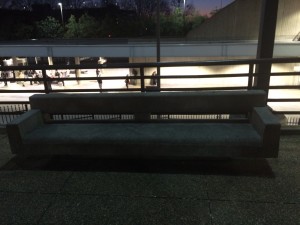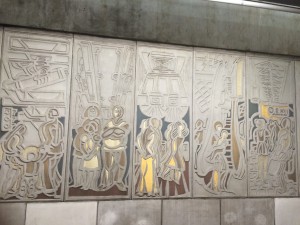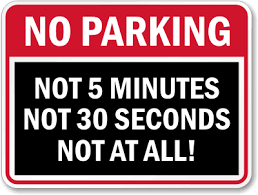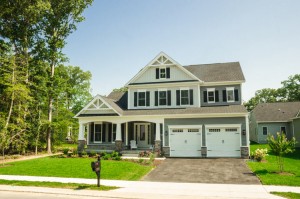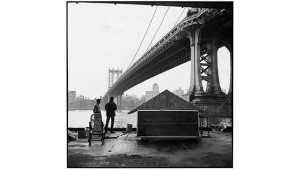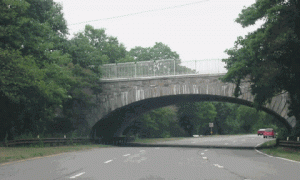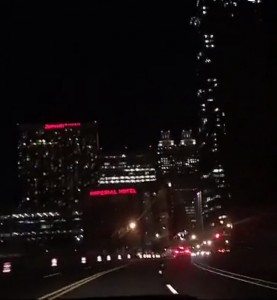Exterior #2
This is a bench outside of the Marta station. It is made of concrete so it’s not very comfortable to sit down on. I think it’s more a show peace, then something you can sit on. It’s located close to the street and it was cold so the wind from the passing cars makes it a bad location for a bench. The style is very modern, almost imitating a couch.
Exterior #1
This is a part of a mural located as soon as you get off the Marta train. Each part of the mural tells a story. This part of the mural tells about a family of three, Mom dad and daughter, taking a train ride. The detail in each mural was mesmerizing. You could really see the stories coming out if you stopped and looked long enough, but at first I didn’t see it, but then I stopped to take a picture and realized it was a story.
Annotated Bibliography 1-3
Stupich, Martin, 1949-. MARTA. Kenan Research Center, Atlanta History Center, 130 West Paces Ferry Road, Atlanta GA 30305, 2006. EBSCOhost. Web.
This book is about the history of Marta. It is intended for gaining knowledge on Marta and its beginnings. This source has helped me identify the rhetoric in this built environment. This book tells when Marta was built and the obstacles it faced going through the years to become the wide spread bus system it is today. I chose this sources because of it fact based content. It provides a background for my exterior built environment, and helps paint a mental picture of what Marta was then compared to how it is now. Using only second hand articles may have more opinion based information. The flaws with this book is its outdated content doesn’t account for new developments and achievements. This book was published in 2006 which is a ten year gap of information. This book relates to my other resources because it offers an unbiased opinion compared to the web articles used.
THOMPSON, CLIVE. “No Parking Here.” Mother Jones 41.1 (2016): 16-25. MasterFILE Elite. Web. 5 Feb. 2016.
This journal article is about the availability of space for parking in big cities like Atlanta. It is intended to show the change in car usage of adults who became young adults at the beginning of the millennium, and the environmental impact of creating more parking spaces and vice versa . This journal article describes the overall experience of a driver in Atlanta: the space, parking, ability to locate certain buildings. I chose this journal article because its viewpoint from the people experiencing and living in this built environment. Since this is a personal article, it lacks credibility and is more opinion and experienced based, than experimental and fact based. The author of this journal article also seems biased on the topic making it open to skepticism. This article relates to my other article because it shows that since the availability to maneuver in Atlanta with a car is less than favorable; people are seeking an alternative mode of transportation, Marta.
Connor, Michan Andrew. “METROPOLITAN SECESSION AND THE SPACE OF COLOR-BLIND RACISM IN ATLANTA.” Journal of Urban Affairs 37.4 (2015): 436–461. Print.
This journal article is about the majority white cities in DeKalb and Fulton County. In 2011 a lawsuit was filed for the desegregation of these majority white cities. The case was voted against for the reason that it not a race issues is a social class divide, and they happen to be majority white. This article relates to an article we have read in class about the use of architect to segregate neighborhoods, and I chose this journal article because it relates to the built environment. This article flaw is that it is a court case that was tried in 2011. In the five years since the case, understanding of discriminating have gotten more attention (i.e. same sex marriage) making this outdated. This article relates to my other articles because of its evidence of how the built environment of high income homes are influencing the need for lower income homes; which, needs more land to build.
Question??
Question????
Reading Summary 2 (NERSESSOVA, IRINA. “Tapestry Of Space: Domestic Architecture And Underground Communities In Margaret Morton’s Photography Of A Forgotten New York)
This article talks about the use of photography to unveil the forgotten New York. Looking at New York you would describe it as one of the U.S busiest cities. Look closer you see the many different people living there the art all around the neighborhoods. This is how far people look when describing New York. Why not look deeper into New York? You will see the crime and poverty running through the streets. The homeless population is often overlooked even though it has been an issue for quite some time. There are so many buildings for living yet still an overwhelming amount of homeless people, who contribute their own structures to the cities by building a shelter using personal belongings and materials found on the streets.
This article is not to attach New York on its system of dealing with the homeless population, or the lack thereof, but to make a spectacle out of what has been hidden in plain sight. Homes, not homeless, treats homelessness as something you can’t become. Homes are superior to the homeless, but why does the homeless care. The pictures used show that the homeless, not homes, are one in the same. Although, not the socially accepted, the homes built by the homeless are the same as the houses built and lived in by the homes. Life, even though not socially recognized, for the homeless are similar in ways that some have pets. How do you have a dog and be homeless? Same reason why others own dogs: companionship, protection, physical needs…etc.
Morton’s tunnel photographs show not just where the homeless live, but those out to destroy them. Homelessness can’t be defined as a condition of not having a home; because the homeless have homes. Government demolishes these homes because of their lack of valid material and visual appeal. This shows you how unstable a home can be. Making homes and the homeless the same, but what loss is loss from a home losing their home and the homeless losing their home? The feeling of loss is universal but more recognized in the homeless population. Morton’s view on shelter and the lack of shelter on ones physiological state is shown through interviews and even through some of her photographs. Many people in the tunnel stay, while others try their luck outside of them.
Morton interviews a homeless man named Doug. His description of the east river describes a different,yet closer look at what is seen just by a glance. He says “You may drive by here and see that they are shabby, but I think that if you look again you see this person took the time to build a place that could be comfortable for himself…The person who will take the time to build for himself is the person who still has an interest in himself.“(NERSESSOVA, IRINA) Goals of the situationalist internationalists are to blur the lines between art and life, but I believe Morton’s view is that there is no line. Life is like a work of art. Look beyond what’s hidden behind rusted material to see how we can tell the homes from the homeless.
Sources
NERSESSOVA, IRINA. “Tapestry Of Space: Domestic Architecture And Underground Communities In Margaret Morton’s Photography Of A Forgotten New York.” Disclosure 23 (2014): 26. Advanced Placement Source. Web. 20 Nov. 2015.
Reading Summary 1 (SCHINDLER, SARAH. “Architectural Exclusion: Discrimination And Segregation Through Physical Design Of The Built Environment.”)
This article looks into the time of discrimination in a new less obvious way, architecture. Robert Moses known as a master builder in New York, was known for his bridge work. More recognized for his intentional bridge design,that lowered bridge heights so that buses wouldn’t be able to pass under them. Why didn’t he want buses? Busses are used majorly by poor and minorities. Bringing unwanted noise and crime. Was this the real reason or was it more to it than they were letting on? Bus systems like MARTA are under criticism today for this very reason, but life is considerably different from the 1970s. In 1974, the city of Memphis, white residents request that a street be closed off, which connects a majority white and black neighborhoods. When brought to the Supreme Court it was ruled as a “routine burden of citizenship and slight inconvenience” (Schindler, S…) Justice Marshall didn’t withhold acknowledging the message hidden behind this.
Laws and lawmakers which are intended to help prevent racial discrimination are a main contributor to the very things it seeks to prevent. Regulations, requirements, even structural designs are all tactics that lead to discouraging certain groups to migrate over to other locations. Lawrence Lessig’s regulatory theory which states that behavior can be regulated or contained by architecture. (Schindler, S…) Regulations enforced by architecture is harder to identify through the courts because they are less noticeable, not as direct, and generally unfamiliar to the eyes we use to see the world everyday (common eyes). We do have laws that prevent discrimination through architecture, for example, through the Americans with Disabilities Act which gave us handicap parking and ramps. Obvious architectural exclusion or human right that just so happened to involve the changing architectural design to allow accessibility to other places, but how does this differentiate from the low bridges restricting minorities and poor from going into certain neighborhoods?
Architectural discrimination is not always intentional. When constructing a new highway or Bridgeway constructors plan on location, traffic accessibility and economic impact. Looking at it as a built environment a highway can divide two neighborhoods, making it inconvenient to associate with each other. Politically, however, according to Lessig “That the Constitutional Court in Germany is in Karlsruhe, while the capital is in Berlin, limits the influence of one branch of government over the other. These constraints function in a way that shapes behavior. In this way, they too regulate.” (Schindler, S…) Here Lessig is not directly acknowledging that there are architectural constraints, but refers to them as “codes”, like technology linking together the behaviors or real world architecture to cyberspace. Legally physical exclusion through the use of architecture can easily be overlooked because structures are built according to laws. Laws made over a century ago to prevent to races from interacting are still used causing neighborhoods to still be segregated.
This article was to seek attention on the use of architecture to bring together or separate certain people. However you may see the world around you, this article hopes to enlighten the common eyes, scholars, politicians, courts, and citizens’ eyes to see what may seem innocuous and according to law may have meaning to regulate and control the environment around them. Although signs and laws that divide us racially were taken down; new lines were drawn using architecture as the pen.
Sources
Schindler, Sarah. “Architectural Exclusion: Discrimination and Segregation Through Physical Design of the Built Environment.” Yale Law Journal. 124.6 (2015): 1934-2024..Web. 24 Jan. 2016.
City View
Syllabus Quiz
What are the major projects?
• Our major Projects are the Built Environment Analysis and the Built Environment Descriptions.
In a bulleted list, provide links to the project descriptions for each of them.
• http://spaceplacerhet.robinwharton.net/syllabus-course-info/#BEDescriptions
• http://spaceplacerhet.robinwharton.net/syllabus-course-info/#BEAnalysis
How will your final grade be calculated?
• Grades are calculated in points. You will receive points for just about anything. Coming to class, completing class work, major projects, and adding to the gallery of the Environment of Atlanta.
What is the “submission form” and how do you use it?
• You can use the Submission form to turn in everything for credits. Just make sure to add your name, GSU email, Instructor, and the link to you assignment.
Embed the form below your answer (hint: Google “embed Google form” to find out how).
Embed the course calendar and weekly overview below this question.
• http://spaceplacerhet.robinwharton.net/syllabus-course-info/#WeeklyOverview
Where on the course website can you find an overview of what’s due and the readings for each unit?
• You can see what due in the week by the weekly overview.
What is the best way to see an overview of what’s due each week?
• Through the weekly Overview
What is the attendance policy?
• Attendance adheres to the GSU attendance policy and individual exemptions are handled on case to case bases.
What are my office hours, and how do you make an appointment to see me outside of class?
• Office hours are Monday and Wednesday 9-11 am or through Skype or Google hangout
How do you earn participation credit? Provide a link to the instructions/guidelines for participation.
• http://spaceplacerhet.robinwharton.net/syllabus-course-info/#Participation
How many points can you earn by participating in or organizing a study group session?
• You can earn up to 25 points
How can you be assured of earning an “A” in this course?
• On top of doing your regular assigned work adding in extra submissions and contributions to the archive of Atlanta environment earns you extra points.
What are the minimum requirements for earning a passing grade of “C”?
• Doing the bare minimum of the required work assigned gives you a passing grade.
What do you do if you’re not sure how to document your participation in order to earn points?
• If you have any questions go to office hours to ask questions for help and clarity.
